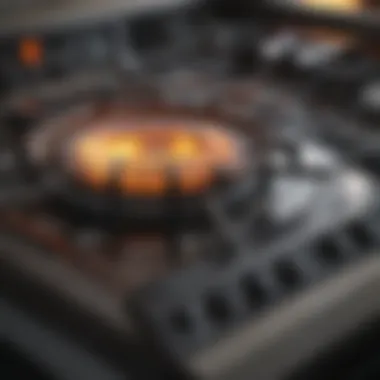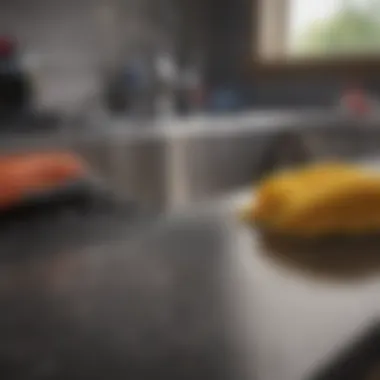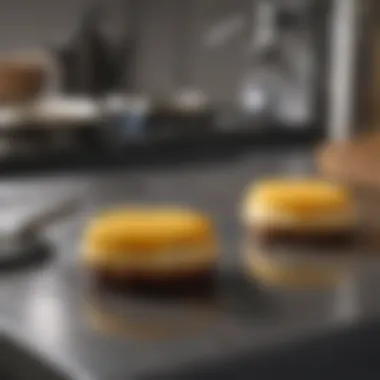Top Effective Techniques for Removing Grease from Stoves


Intro
Maintaining a clean stove top is crucial for both hygiene and aesthetics. This task becomes especially daunting when grease builds up after each cooking session. Knowing effective methods for removing grease is essential for anyone who values a tidy kitchen and a comfortable cooking space.
In this guide, we will explore various cleaning strategies designed to tackle grease without damaging your stove surface. From tried-and-true techniques to innovative solutions, each method serves an important role. By the end, readers will be equipped with the knowledge to keep their stove tops sparkling clean with minimal effort.
Understanding Grease
Grease is a byproduct of cooking that results from fats in food. It can quickly accumulate on stove tops if not cleaned properly. Ignoring this residue can lead to unforeseen complications, including unpleasant odors or even compromised functionality of your cooking appliances. A thorough understanding of grease composition can aid individuals in selecting the right cleaning techniques.
Equipment Needed
Before diving into methods, having the right tools on hand will streamline the cleaning process. Here are some essential items:
- Sponges or microfiber cloths
- *Scrapers for stubborn stains
- Stiff brushes
- Cleaning solution – this can be a kitchen-specific cleaner or a homemade mixture
- Gloves to protect your hands
- Bucket for rinsing
With this equipment, the procedure can proceed efficiently and effectively.
Innovative Techniques
There are a multitude of ways to remove grease from stove tops, but not all methods have the same level of effectiveness. Below are detailed descriptions of traditional and modern techniques.
Traditional Techniques
- Baking Soda and Water Paste
Combine baking soda with water to form a paste. Apply it to the greasy areas and let it sit for at least fifteen minutes before scrubbing. Rinse with a damp cloth afterwards. - Vinegar Solution
Spray diluted vinegar on the stained areas. The acidity helps cut through grease. After a few moments, wipe it down with a sponge. - Dish Soap
Using a few drops of dish soap mixed with hot water can also effectively lift grease. This method is suitable for regular maintenance.
Modern Solutions
- Commercial Cleaners
Consider using commercial cleaning products dedicated to kitchen surfaces. Follow the instructions and ensure thorough rinsing post-application. - Steam Cleaners
Utilizing a steam cleaner can offer an eco-friendly approach to grease removal without heavy scrubbing.
Tip: Always test a small inconspicuous area before applying any cleaner to check for damage or discoloration.
Incorporating these techniques can drastically reduce grease buildup over time, making kitchen maintenance more manageable. Being mindful of the specific materials of your stove will guide your choice of methods.
Maintaining cleanliness on stove tops serves as a reminder that a well-kept kitchen is at the heart of any home. Proper cleaning methods contribute not only to appearance, but also to the longevity of cooking appliances. Thus, staying educated and equipped with the right cleaning techniques is fundamentally linked to creating a healthy cooking environment.
Prolusion to Kitchen Grease
Kitchen grease is a pervasive nuisance familiar to anyone who cooks. Grease can accumulate quickly, transforming a clean stove top into a difficult surface to maintain. Understanding the nature of kitchen grease is essential to achieving effective removal. It is important to know both the composition and the sources of grease to formulate a successful cleaning strategy.
Understanding Kitchen Grease
Kitchen grease primarily consists of fat and oils from cooking substances. Whether from meats, oils, or other fatty ingredients, these substances can splatter or bake onto the stove surface while cooking. Over time, they build up and form a sticky residue that is not only unsightly but also traps dirt and bacteria. Grease can emit unpleasant odors and can even affect the flavor of the food prepared in a greasy kitchen.


This buildup is not simply aesthetic; it can turn into a slippery hazard or a focal point for pests in the kitchen. Knowing how grease reacts to different cleaning agents can also be useful for the kind of approach that you choose.
Common Sources of Grease
Identifying the sources of kitchen grease is critical for anyone aiming to keep their stove tops clean. Common culprits include:
- Cooking Oils: Vegetable oils, olive oils, and fats can splatter while frying or sautéing.
- Frying Meats: When cooking meats, especially fried items, they release a significant amount of grease.
- Baked Goods: Baking can also leave greasy residues, mainly when using butter or oils in the mixing process.
- Spills during Food Preparation: Even simple tasks like chopping vegetables can lead to accidental spills.
Each of these sources pours grease onto the stove surface, leading to buildup that requires attention. Taking the time to understand where grease originates not only aids in prompt clean-up but also helps in developing preventative measures for the future. Keeping this insight on kitchen grease will significantly inform the cleaning methods discussed in later sections.
Tools and Materials Needed
In order to successfully remove grease from stove tops, it is essential to gather the right tools and materials. The effectiveness of the cleaning process is often directly related to the quality and suitability of the cleaning supplies and tools used. Selecting appropriate items can not only make the task easier but also improve results, reducing time and effort.
Essential Cleaning Supplies
When it comes to cleaning grease, some supplies are indispensable. Having the following cleaning agents on hand saves both effort and time:
- Dish Soap: This helps break down grease and makes it easier to wipe away. It is effective in loosening debris from surfaces.
- White Vinegar: This is a natural degreaser. Its acidity cuts through grease and leaves no residue.
- Baking Soda: A mild abrasive, baking soda works very well together with vinegar for tough stains.
- Lemon Juice: Besides its pleasant scent, it is also an effective degreaser due to its acid.
Having these supplies readily available assists in maintaining a clean stove top with less hassle.
Recommended Cleaning Tools
The right tools can considerably enhance your cleaning efforts. Here are some recommended items:
- Soft Cloths or Sponges: Opt for non-abrasive cloths to avoid scratching surfaces. A microfiber cloth can be particularly effective for trapping grease.
- Scrub Brushes: A deployable scrub brush can provide the necessary scrubbing power for baked-on grease without damaging the stove's area.
- Spray Bottles: Easily dilute your cleaning products with water and spray directly onto greasy areas for an efficient application.
- Extra-Absorbent Towels: These can be useful for drying surfaces after cleaning, to prevent any streaks or additional grime.
Utilizing the right tools not only enhances the efficiency of the cleaning process but also ensures the longevity of your kitchen appliances.
"Using the correct tools and supplies can dramatically affect the outcome of your cleaning efforts. It simplifies tasks and gives a more polished finish."
Step-by-Step Guide to Remove Grease
Removing grease from stove tops requires a systematic approach. This section provides an effective step-by-step guide. Following these methods ensures that you don't miss any important detail, leading to a tidy and hygienic kitchen space. By engaging in a thoughtful process of preparation and execution, one can achieve optimal results with less effort in the long run.
Preparing the Stove Surface
Before applying any cleaning solution, preparing the stove surface is crucial. First, turn off all burners entirely and allow the surface to cool. Safety should be paramount. Next, gather larger debris like food particles and crumbs with a cloth or paper towel. This will ensure your cleaning solution can work more effectively on the grease itself. Consider laying down a tarp or some old newspapers under the stove to catch any drips or stains, protecting your floor.
Applying Cleaning Solutions
Once the surface is clean, it's time to apply your chosen cleaning solution. If you go with a natural approach, you may choose a vinegar and baking soda mix. Spray or directly apply the solution, ensuring an even coating. This method invites chemical reactions that help loosen tougher grease. If using a commercial cleaner, kindly read and follow the instructions on the label. It might be beneficial to allow the solution to sit for some minutes—this ensures deeper penetration into the grease.


Scrubbing Techniques
After allowing your cleaning solution to soak, a suitable scrubbing method plays a key role. Use a microfiber cloth or a soft sponge for effective scrubbing. Avoid abrasive pads, as they may scratch the surface. Start at one corner, working your way across the stove in a side-to-side motion. Use moderate pressure—too much and you may damage the surface; too little might not clean well. As greasy residue lifts, periodically rinse your cloth or sponge to avoid redepositing grime back onto the stove.
Rinsing and Drying the Surface
After scrubbing, rinsing correctly is fundamental. Use a clean cloth dampened with warm water to wipe away the cleaning solution. This step ensures that residues from either commercial or natural solutions are fully removed. After rinsing, dry the stove top using a towel or microfiber cloth. This prevents streaks and highlights any spots you may have missed. Taking the time to do this can lead to a gleaming countertop, reflecting mere cleanliness while safeguarding longevity.
"A clean stove is not only pleasing to the eye but is also imperative for safe kitchen operations."
The above steps showcase a straightforward process. Committing to this process routinely can lead to less arduous cleaning sessions in the future, contributing significantly toward an organized cooking environment.
Effective Natural Cleaning Solutions
Natural cleaning solutions are important for many owners since they usually offer effective and safe methods for removing stubborn kitchen grease. With growing awareness of health and environmental issues, natural solutions also resonate with a broad audience. Here, we will discuss two widely recognized avenues: vinegar and baking soda, and lemon juice with olive oil. Each provides unique benefits and considerations when dealing with grease.
Vinegar and Baking Soda
Vinegar and baking soda stand out as powerful cleaning agents due to their chemical properties. Vinegar contains acetic acid, which helps to break down grease and grime effectively. This effectiveness makes it an ideal choice for a thorough clean.
On the other hand, baking soda is an alkaline compound which works by interacting with acids like those found in common cooking residues. When combined, the fizzing action produced can help lift dirt and grime from surfaces. This tactile action makes the cleaning process easier while delivering optimal results in grease removal.
Instructions for Use:
- Spray vinegar on the stained areas of the stove top.
- Sprinkle baking soda over the vinegar-sprayed spots. Allow the two to react and fizz for a few minutes.
- Gently scrub the surface using a cloth or sponge.
- After scrubbing, wipe down the area with a damp cloth to remove any residues.
- Ensure the surface is dried properly after cleaning to avoid water spots.
Using vinegar and baking soda is inexpensive from an economic standpoint. Some might already have them at home, making this method easily accessible for anyone looking to maintain clean stove tops.
Lemon Juice and Olive Oil
Combining lemon juice and olive oil provides a natural method with dual benefits. Lemon juice contains citric acid, which possesses strong germicidal properties. It can break down grease effectively while providing a fresh scent, which adds an extra touch after cleaning.
Olive oil also plays a significant role here. While it may seem counterintuitive, olive oil is effective in conditioning surfaces, preventing future build-up. When used as part of a cleaning solution, it can prevent stains from forming as readily.
Instructions for Use:
- Squeeze fresh lemon juice on the grease-covered spots of the stove.
- Apply a small amount of olive oil onto a cloth.
- Use the cloth to scrub the surface in circular motions. This helps lift any greasy residues.
- Wipe off with a clean, damp cloth to remove all
Commercial Cleaners for Grease Removal
Understanding commercial cleaners is an essential part of effectively removing grease from stove tops. These products are specially engineered to address stubborn grime and leave your surfaces spotless. They offer potent solutions that are often more effective than homemade mixtures, which can result in cleaner and less time-intensive maintenance routines. Furthermore, they come in several formulations tailored to different surfaces and grease types, providing versatility and choices.
Types of Commercial Cleaners


Many varieties of commercial cleaners can be beneficial for grease removal. Here are some popular ones:
- Heavy-Duty Degreasers: Formulated specifically for tough grease, these products break down and emulsify oils quickly.
- Foaming Cleaners: These are designed for cling, allowing the solution to penetrate stains without running off. It’s excellent for vertical surfaces.
- Multi-Surface Cleaners: These are more versatile and can be used on various surfaces. However, ensure they are suitable for your specific stove type.
- Natural Enzyme Cleaners: An eco-friendly option, these use biological enzymes to address grease. While they may be less caustic, they often require more time to work effectively.
Assessing the specific needs of your stove and the nature of the grease helps in selecting the right product.
Safety Considerations
When using commercial cleaners, safety is paramount. Many cleaners contain chemicals that can pose health risks if not handled correctly. Here are some important safety practices:
- Read Labels: Before using, check the label for proper instructions. Understanding what chemicals are involved is critical to safe usage.
- Proper Ventilation: Ensure the area is well-ventilated when applying chemicals. This minimizes inhalation risks of harmful fumes.
- Use Protective Gear: Gloves and masks can mitigate skin and respiratory exposure to irritating substances.
- Store Safely: Keep cleaners out of reach of children and pets. Proper storage can prevent any accidental ingestion.
Being aware of correct safety measures allows for effective use of commercial cleaners while minimizing potential risks.
Preventing Future Grease Build-up
It's not just about cleaning up grease after it has settled on your stove top. Preventing future grease build-up is just as crucial. Regular maintenance not only enhances the appearance of your kitchen but also reduces the time and effort needed for deep cleaning sessions. Preventive measures are cost-effective and can extend the life of your kitchen appliances. They also contribute significantly to a hygienic cooking environment, keeping potential contaminants at bay.
Regular Maintenance Practices
Maintaining a clean stove requires consistent effort. Applying simple maintenance routines can help mitigate the accumulation of grease.
- Daily Wipe-down: It is advisable to wipe down the stove after every meal. Use a soft cloth or sponge soaked in warm soapy water to remove any splatters immediately.
- Create a Clean Habits Routine: Designate specific times during the week dedicated to thorough cleaning. This minimizes grease build-up advantages.
- Use a Protective Cover: When not in use, consider covering your stovetop to keep dust and particles away.
- Capture Grease with Vents or Filters: Effective ventilation and using stovetop filters can capture grease as you cook. Replace or clean them regularly for maximum efficiency.
Best Practices in Cooking
Adopting certain cooking habits can have a significant impact on reducing grease production during meal preparation.
- Cook with Lids: Whenever possible, cooking with pots and pans covered helps limit splatter.
- Control Heat Levels: Cooking at high heat can cause more splatter. Keeping the temperature at moderate levels can limit excessive grease development.
- Select Proper Cookware: Nonstick pans and those designed to minimize grease flare-ups attract less grease.
- Clean Utensils Promptly: Immediately clean cooking utensils that may retain excess grease. Do not wait; clean as you go.
By implementing these practices, grease build-up can be significantly diminished. This approach not only makes future cleaning tasks less daunting but also contributes to a more pleasant cooking atmosphere.
Remember, consistency is the key! A little bit of effort on a regular basis can save you from extensive scrubbing later.
Epilogue
The importance of removing grease from stove tops cannot be understated. Grease not only detracts from the visual appeal of a kitchen, but it can also be a health hazard. A clean stove promotes a hygienic cooking environment, ultimately ensuring food safety. Furthermore, cleaning grease regularly can prolong the lifespan of kitchen appliances and enhance their performance.
Summary of Effective Methods
Effective methods for grease removal discussed in this article include strategies such as using natural cleaning solutions and specific commercial products. Natural options like vinegar combined with baking soda and the acidic properties of lemon juice can effectively cut through grease build-up. On the other hand, commercial degreasers are designed for practical use and deliver fast results when used according to the manufacturer's instructions. Educating yourself about these methods makes it easier to keep a clean stove top.
Encouragement for Consistent Cleaning Routines
Maintaining a regular cleaning routine is essential to prevent the severe build-up of grease over time. Setting a specific time weekly or bi-weekly for kitchen cleaning can create a productive habit. Encouraging family involvement in cleaning responsibilities can also foster teamwork and teach responsibility.
Prioritizing communal effort in keeping the stove clean allows for an efficient and pleasant cooking environment. One suggestion could be to briefly wipe down the stove after every use. This practice alone can mitigate tedious, extensive cleaning tasks down the line. Additionally, as you educate yourself more on cooking techniques, discussing best practices can reduce grease production in the first place and lead to a healthier kitchen overall.
Cleanliness in the kitchen reflects care—the double benefit of hygiene and aesthetic appeal.



